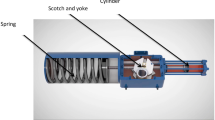Abstract
A silicon-chromium alloy frequently used for heavy-duty diesel engine intake valves was tested against eight different insert materials with a valve seat wear simulator. Wear resistance of these combinations was ranked. For each test, the valve seat temperature was controlled at approximately 510 °C, the number of cycles was 864,000 (or 24 h), and the test load was 17,640 N. The combination of the silicon-chromium valve against a cast iron insert produced the least valve seat wear, whereas a cobalt-base alloy insert produced the highest valve seat wear. In the overall valve seat recession ranking, however, the combination of the silicon-chromium valve and an iron-base chromium-nickel alloy insert had the least total seat recession, whereas the silicon-chromium valve against cobalt-base alloy, cast iron, and nickel-base alloy inserts had significant seat recession. Hardness and microstructure compatibility of valve and insert materials are believed to be significant factors in reducing valve and insert wear.
The test results indicate that the mechanisms of valve seat and insert wear are a complex combination of adhesion and plastic deformation. Adhesion was confirmed by material transfer, while plastic deformation was verified by shear strain (or radial flow) and abrasion. The oxide films formed during testing also played a significant role. They prevented direct metal-to-metal contact and reduced the coefficient of friction on seat surfaces, thereby reducing adhesive and deformation-controlled wear.
Similar content being viewed by others
References
K. Zinner,“Investigations Concerning Wear of Inlet-Valve Seats in Diesel Engines,” ASME Paper No. 63-OGP-1, American Society of Mechanical Engineers, 19–23 May, 1963
K.L. Brown and N.D. Bohner,“Valve Wear, Statistically Speaking,” ASME Paper No. 77-DGP-6, American Society of Mechanical Engineers, 1977
S.L. Narasimhan and J.M. Larson,“Valve Gear Wear and Materials,” SAE Paper No. 851497, Society of Automotive Engineers, 1985
R. Van Dissel, G.C. Barber, J.M. Larson, and S.L. Narasimhan,“Engine Valve Seat and Insert Wear,” SAE Paper, No. 892146, Society of Automotive Engineers, 1989
Y.S. Wang, S.K. Schaefer, C. Bennett, and G.C. Barber,“Wear Mechanisms of Valve Seat and Insert in Heavy Duty Diesel Engines,” SAE Paper No. 952476, Society of Automotive Engineers, 1995
T.N. Tunnecliff and L.F. Jenkins,“Why Valves Succeed,” SAE Paper 249B, Society of Automotive Engineers, 1960
R. Zhao, G.C. Barber, Y.S. Wang, and J.E. Larson, Wear Mechanism Analysis of Engine Exhaust Valve Seat with a Laboratory Simulator,STLE Trans., Vol 40 (No. 2), 1997, p 209
M.J. Malatesta, G.C. Barber, J.M. Larson, and S.L. Narasimhan, Development of a Laboratory Bench Test to Simulate Seat Wear of Engine Poppet Valves,Tribol. Trans., Vol 36 (No. 4), 1993, p 627
Author information
Authors and Affiliations
Rights and permissions
About this article
Cite this article
Wang, Y.S., Narasimhan, S., Larson, J.M. et al. Wear and wear mechanism simulation of heavy-duty engine intake valve and seat inserts. J. of Materi Eng and Perform 7, 53–65 (1998). https://doi.org/10.1361/105994998770348043
Received:
Revised:
Issue Date:
DOI: https://doi.org/10.1361/105994998770348043




